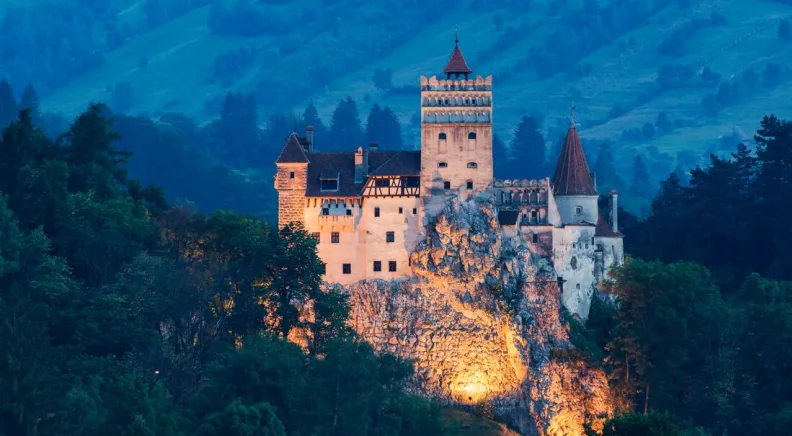Even without its bloodcurdling myths of Dracula, werewolves, haunted castles and curses, Romania is the perfect atmospheric place to spend an eight-day trip in October. You’ll be introduced to the beauty of ancient Bucharest, the haunting mythology of Sighisoara and the nostalgic atmosphere of Bran Castle (aka Dracula’s castle) in Brasov. Take a daytrip to the Hoia Forest, steeped in legend and ghost stories and dress up for a party after sundown with your fellow travellers. For a spine-tingling adventure this spooky season, don’t look past Transylvania... mwahahaha.


Halloween in Transylvania (Southbound)
Deal number: 9868513
Intrepid
This deal expires 27 Dec 2025
From 26/10/2026 to 06/11/2027
Romania
8-day tour
Price from
$2,970*
per person
Deal number: 9868513
Visit the 12th-century town of Sighisoara – the birthplace of Count Dracula (allegedly). Things are about to get medi-evil.
Break out your scariest costumes for a spooky Halloween party, where haunted tunes will echo through cobweb-covered corridors and lanterns will light up the foggy night.
Protect yourself against devils and demons with a visit to the Turda Salt Mines – a fascinating museum and underground amusement park showcasing the history of salt in the region.
Take a trip to the spooky Hoia Forest, known for ghost stories, UFO sightings, strange trees and questionable photos showing things unseen to the naked eye. You’ll meet with a local guide for a 3-hour hike packed with legends.
See the traditional Saxon village of Viscri for some traditional Romanian hospitality and some finger-licking home-cooked food.
Breakfasts Included: 7
Lunches Included: 1
Hotel ( 7 nights)
Train, Private vehicle, Taxi, Public Bus
Age: min 15
Group Size: 1 - 16
Transylvania - Halloween Party
Turda - Salt Mines Tour
Cluj Napoca - Walking Tour with Local Guide
Cluj Napoca - Hoia Forest Guided Trek
Viscri - Fortified Church
Viscri - Local Home Cooked Lunch
Bran Castle - Tour
Brasov - Walking Tour with Local Guide
Bucharest - Walking Tour with Local Guide
Break out your scariest costumes for a spooky Halloween party, where haunted tunes will echo through cobweb-covered corridors and lanterns will light up the foggy night.
Protect yourself against devils and demons with a visit to the Turda Salt Mines – a fascinating museum and underground amusement park showcasing the history of salt in the region.
Take a trip to the spooky Hoia Forest, known for ghost stories, UFO sightings, strange trees and questionable photos showing things unseen to the naked eye. You’ll meet with a local guide for a 3-hour hike packed with legends.
See the traditional Saxon village of Viscri for some traditional Romanian hospitality and some finger-licking home-cooked food.
Breakfasts Included: 7
Lunches Included: 1
Hotel ( 7 nights)
Train, Private vehicle, Taxi, Public Bus
Age: min 15
Group Size: 1 - 16
Transylvania - Halloween Party
Turda - Salt Mines Tour
Cluj Napoca - Walking Tour with Local Guide
Cluj Napoca - Hoia Forest Guided Trek
Viscri - Fortified Church
Viscri - Local Home Cooked Lunch
Bran Castle - Tour
Brasov - Walking Tour with Local Guide
Bucharest - Walking Tour with Local Guide
1 Cluj Napoca
Buna Ziua! Welcome to Cluj Napoca – the unofficial capital of Romania’s Transylvania region. Your adventure begins with a welcome meeting at 6 pm tonight to meet your trip leader and fellow travellers. If you arrive early, you might like to explore this 2000-year-old city on foot or hit up the famous Piezisa Street for a drink.
2 Turda Salt Mines / Cluj Napoca
This morning, visit the Turda Salt Mines – a former salt mine converted into an underground amusement park. Maybe hire a rowboat, go bowling or visit the museum showcasing salt mining in the region – the options are endless! Salt is thought to be a protective tool against all sorts of evil beings and legend has it that if you pour an unbroken line of salt across the entranceway to your house, vampires and demons won’t be able to get in. After your salt mine visit, return to Cluj for a city tour with a local guide. The remainder of the day is yours to explore at your own pace.
3 Cluj Napoca
Today, you’ll head out for a daytrip to the Hoia Forest – a famous haunted forest with reports of ghost stories, apparitions, faces identified in photos and UFO sightings. Over the years, locals and tourists report anxiety and the feeling of being watched in this forest and the local vegetation features strangely shaped trees and charring on tree stumps and branches. The forest became famous in the late 1960s when a military technician took photos of a UFO above Poiana Rotunda (Round Meadow). If you’re lucky, the forest may even be covered in mist! After a transfer from your hotel, you’ll meet with a local guide for a 3-hour hike within the forest, along gentle hills and valleys. Listen to the legends and visit the Round Meadow where the first UFO was sighted. After, head back to your hotel for a free afternoon.
4 Sighisoara
Travel by train through pastoral fields and untouched Saxon towns to the 12th-century town of Sighisoara. Medieval Sighisoara is likely to seduce visitors more than any other place in Romania. The town is famed as the birthplace of Vlad Dracul III, better known as Vlad the Impaler, the ruler of Walachia province from 1456 to 1462 and whose name was the inspiration for Bram Stoker’s iconic Count Dracula. Walking through the town is like taking a trip back in time to the medieval age, and it’s easy to image streets crowded with vampires, evil counts, wolves, peasants riding through the untamed countryside on horse-drawn carts and crooked old men doddering along the narrow streets. Head out with your leader for a quick orientation walk, then spend the rest of your day exploring in your own time.
5 Viscri
After a free morning in Sighisoara, you’ll travel to Viscri – this small Transylvanian village was originally inhabited by Saxons from the Luxembourg area, and the whole scene is picture-postcard rural. This idyllic village of red tiled roofs is also a UNESCO World Heritage site, virtually unchanged for 900 years. After a home cooked lunch at the house of a local family, you’ll visit the town's fortified church (thought to be the oldest in Transylvania). Continue to the 13th-century city of Brasov in the afternoon. Also known by its German name of Kronstadt, this town flanked by mountains and city walls was once a major medieval trading centre.
6 Bran Castle/Brasov
No trip to Romania would be complete without a visit to the famous Bran Castle. The castle was built by the Saxons in 1382 to defend the Bran pass against the invading Turks. With its fairy-tale turrets and whitewashed walls, it's far from menacing and spooky, but is undeniably impressive, sitting on a high cliff top and surrounded by pine trees. After, return to Brasov for a guided walk around town, checking out the ornate churches, townhouses, old city walls and squares surrounded by gingerbread-roofed merchants' houses. Visit Brasov's main attraction – the gothic Black Church (Biserica Neagra), which took its name from its blackened appearance after a fire in 1689.
7 Bucharest
This morning, travel by train to Bucharest. Often called the 'Little Paris of the Balkans', Romania's capital is known for its Belle Epoch architecture, thumping nightlife and communist sites. Meet your local guide for a private tour of the city, starting with the recently restored Old Town of Bucharest, then some of the more significant sites of the revolution of 1989, which culminated in the ousting and execution of communist leader Ceausescu. Visit the huge Piata Unirii – one of Europe's largest squares – and the Ceausima – Bucharest's 12-storey Palace of Parliament. The palace is the second largest building in the world, after the Pentagon. The former dictator ordered the construction of this monster, a building of staggering scale and opulence that includes 1100 rooms and 4500 chandeliers.
8 Bucharest
With no further activities planned, your trip ends today and you can depart your accommodation at any time. If you want to stay longer in Bucharest, just speak to your booking agent ahead of time to organise additional accommodation. If you have some extra time, why not take one of the daytrips offered by Urban Adventures. Check out urbanadventures.com for more information.
Buna Ziua! Welcome to Cluj Napoca – the unofficial capital of Romania’s Transylvania region. Your adventure begins with a welcome meeting at 6 pm tonight to meet your trip leader and fellow travellers. If you arrive early, you might like to explore this 2000-year-old city on foot or hit up the famous Piezisa Street for a drink.
2 Turda Salt Mines / Cluj Napoca
This morning, visit the Turda Salt Mines – a former salt mine converted into an underground amusement park. Maybe hire a rowboat, go bowling or visit the museum showcasing salt mining in the region – the options are endless! Salt is thought to be a protective tool against all sorts of evil beings and legend has it that if you pour an unbroken line of salt across the entranceway to your house, vampires and demons won’t be able to get in. After your salt mine visit, return to Cluj for a city tour with a local guide. The remainder of the day is yours to explore at your own pace.
3 Cluj Napoca
Today, you’ll head out for a daytrip to the Hoia Forest – a famous haunted forest with reports of ghost stories, apparitions, faces identified in photos and UFO sightings. Over the years, locals and tourists report anxiety and the feeling of being watched in this forest and the local vegetation features strangely shaped trees and charring on tree stumps and branches. The forest became famous in the late 1960s when a military technician took photos of a UFO above Poiana Rotunda (Round Meadow). If you’re lucky, the forest may even be covered in mist! After a transfer from your hotel, you’ll meet with a local guide for a 3-hour hike within the forest, along gentle hills and valleys. Listen to the legends and visit the Round Meadow where the first UFO was sighted. After, head back to your hotel for a free afternoon.
4 Sighisoara
Travel by train through pastoral fields and untouched Saxon towns to the 12th-century town of Sighisoara. Medieval Sighisoara is likely to seduce visitors more than any other place in Romania. The town is famed as the birthplace of Vlad Dracul III, better known as Vlad the Impaler, the ruler of Walachia province from 1456 to 1462 and whose name was the inspiration for Bram Stoker’s iconic Count Dracula. Walking through the town is like taking a trip back in time to the medieval age, and it’s easy to image streets crowded with vampires, evil counts, wolves, peasants riding through the untamed countryside on horse-drawn carts and crooked old men doddering along the narrow streets. Head out with your leader for a quick orientation walk, then spend the rest of your day exploring in your own time.
5 Viscri
After a free morning in Sighisoara, you’ll travel to Viscri – this small Transylvanian village was originally inhabited by Saxons from the Luxembourg area, and the whole scene is picture-postcard rural. This idyllic village of red tiled roofs is also a UNESCO World Heritage site, virtually unchanged for 900 years. After a home cooked lunch at the house of a local family, you’ll visit the town's fortified church (thought to be the oldest in Transylvania). Continue to the 13th-century city of Brasov in the afternoon. Also known by its German name of Kronstadt, this town flanked by mountains and city walls was once a major medieval trading centre.
6 Bran Castle/Brasov
No trip to Romania would be complete without a visit to the famous Bran Castle. The castle was built by the Saxons in 1382 to defend the Bran pass against the invading Turks. With its fairy-tale turrets and whitewashed walls, it's far from menacing and spooky, but is undeniably impressive, sitting on a high cliff top and surrounded by pine trees. After, return to Brasov for a guided walk around town, checking out the ornate churches, townhouses, old city walls and squares surrounded by gingerbread-roofed merchants' houses. Visit Brasov's main attraction – the gothic Black Church (Biserica Neagra), which took its name from its blackened appearance after a fire in 1689.
7 Bucharest
This morning, travel by train to Bucharest. Often called the 'Little Paris of the Balkans', Romania's capital is known for its Belle Epoch architecture, thumping nightlife and communist sites. Meet your local guide for a private tour of the city, starting with the recently restored Old Town of Bucharest, then some of the more significant sites of the revolution of 1989, which culminated in the ousting and execution of communist leader Ceausescu. Visit the huge Piata Unirii – one of Europe's largest squares – and the Ceausima – Bucharest's 12-storey Palace of Parliament. The palace is the second largest building in the world, after the Pentagon. The former dictator ordered the construction of this monster, a building of staggering scale and opulence that includes 1100 rooms and 4500 chandeliers.
8 Bucharest
With no further activities planned, your trip ends today and you can depart your accommodation at any time. If you want to stay longer in Bucharest, just speak to your booking agent ahead of time to organise additional accommodation. If you have some extra time, why not take one of the daytrips offered by Urban Adventures. Check out urbanadventures.com for more information.
Enquire to book this trip
Deal number: 9868513
Halloween in Transylvania (Southbound)
Intrepid

From 26/10/2026 to 06/11/2027
Romania
8-day tour




